The Ghetto of Rome is a historic district in the centre of Rome, rich in history and tradition, home to the Jewish community for centuries. In this itinerary, you can discover buildings, museums, and monuments, as well as the best places to eat.
Table of Contents
What to see in the Ghetto of Rome
Rome’s Jewish Ghetto is a lesser-known neighbourhood than the capital’s best-known attractions such as the Colosseum, Pantheon, Vatican City, etc. However, I recommend you spend at least half a day there and stop for lunch or dinner to discover this aspect of Rome. Rome’s Jewish community is the oldest in Europe. It has grown in importance over the centuries, enthusiastically experiencing Italian history first-hand, right up to the Shoah, the darkest page of our recent history.
PLAN YOUR TRIP TO ROME
Save money on entrance fees and transportation costs with the Roma Pass. This City Card offers free entry to two attractions, as well as discounts at other museums and archaeological sites, including the Colosseum, the Roman and Imperial Forums, the Capitoline Museums, the Ara Pacis and other must-see.
To stay connected in Italy, remember to buy an Airalo eSim online, with data and phone coverage for your trip to Rome.
Among the best-known sights in the Ghetto of Rome are the Great Synagogue, the capital’s most important synagogue, built in 1904, Via del Portico d’Ottavia, famous for its many restaurants serving Jewish-Romanesque cuisine, Piazza delle Cinque Scole, overlooked by five Jewish synagogues of different rites. To these are added the Jewish Museum on the history of Rome’s Jewish community and the Shoah Museum, run by the Foundation of the same name, to document and hand down the horrors of the racial laws and deportations.

The Jewish Museum of Rome
The Jewish community in Rome is one of the oldest outside Israel. It has been present in the city for over 2200 years without interruption. The Jewish Museum of Rome is in the same building as the Great Synagogue, the city’s largest synagogue. It chronicles the life of the Jewish population in Rome.
Visiting the Jewish Museum, I realised that Rome’s Jewish community is well integrated into Rome’s social fabric and eager to share history and traditions. For instance, before the racial laws, many Roman Jews had experienced 20th-century Italian nationalism, fought and earned medals for bravery in the Great War, just like other Italians.
In addition, some of the museum’s exhibits display objects and family heirlooms, such as Channukkiah and Mezuzà, passed down through generations and donated by people from the Jewish community who wanted to share their history. One room houses a small synagogue of the Spanish rite, made with objects from the ‘Cinque Scòle’, the former synagogues overlooking the square of the same name in the Ghetto of Rome.
The Great Synagogue
Rome’s monumental synagogue, the Great Synagogue, contrasts with the small synagogue inside the Jewish Museum. Designed by non-Jewish architects, the Great Synagogue is similar to Rome’s monumental churches.
For instance, the Torah scrolls are kept behind the altar, as is usually in Catholic churches, but not always in synagogues. In the Great Synagogue, however, there is no lack of some distinctive elements characteristic of synagogues, such as the balcony reserved for women or the lack of images of God that cannot be named or depicted in the Jewish religion.
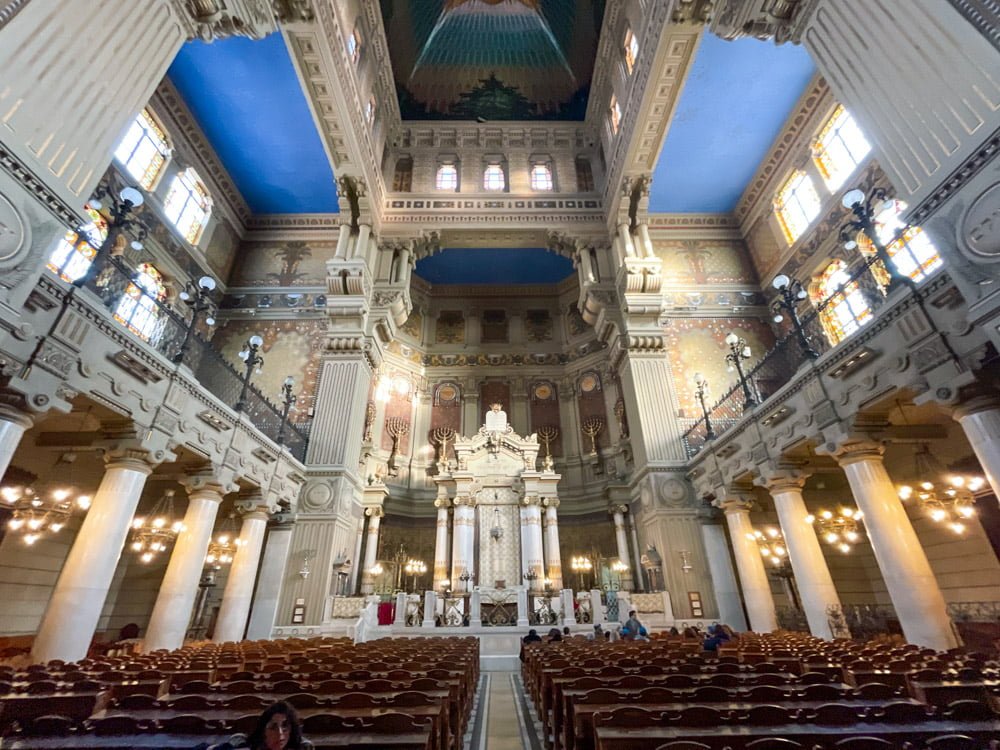
Shoah Museum in Rome
Opposite the Jewish Museum and Great Synagogue complex is the Shoah Museum, a very touching place created to keep alive the memory of the Shoah, the planned extermination of 6 million Jews, now that there are almost no living survivors.
The Shoah Museum collaborates with schools and offers temporary exhibitions dedicated to the Shoah theme. Some exhibits are very intense, which is why I do not recommend a visit with children.
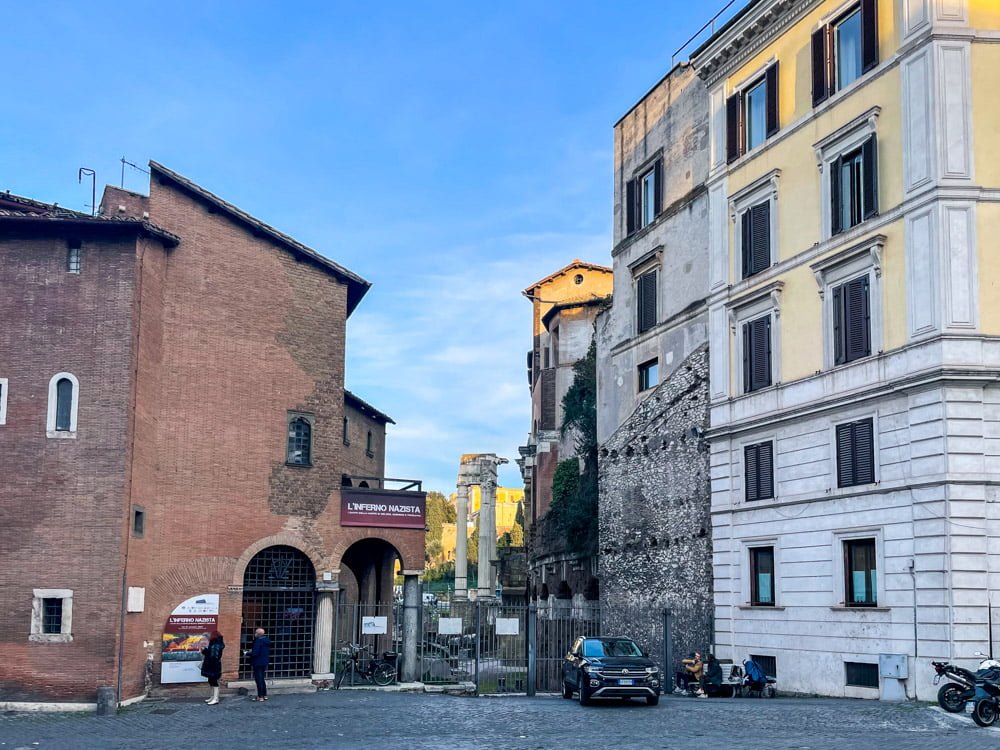
Via del Portico d’Ottavia
Via del Portico d’Ottavia is probably the best-known street in the Jewish Ghetto of Rome. It owes its name to an ancient Roman portico still standing. Today, its fame is mainly due to the restaurants serving Jewish-Roman cuisine. Some restaurants are kosher and, therefore, a reference point for the local Jewish community.
At lunch and dinner, the street comes alive and, on warmer days, is full of tables where you can eat al fresco. The food is fantastic so I recommend stopping to eat in this area. You are spoilt for choice when it comes to Jewish restaurants, pizzerias and bakeries.
Where to eat in the Jewish Ghetto of Rome
The characteristic alleys of Rome’s Ghetto are a great area to stop for a meal or a snack. A tour of Jewish Rome is not complete without ricotta cheese and sour cherry tart or a characteristic artichoke alla giudìa. Jewish-Roman cuisine is, in fact, slightly different from classic Roman cuisine.
The dishes offered by restaurants and bakeries in the Jewish Ghetto have Mediterranean, Spanish and Middle Eastern influences. The combination of Jewish and Italian traditions and ingredients has created unique dishes such as artichokes and cod fillet alla giudìa.
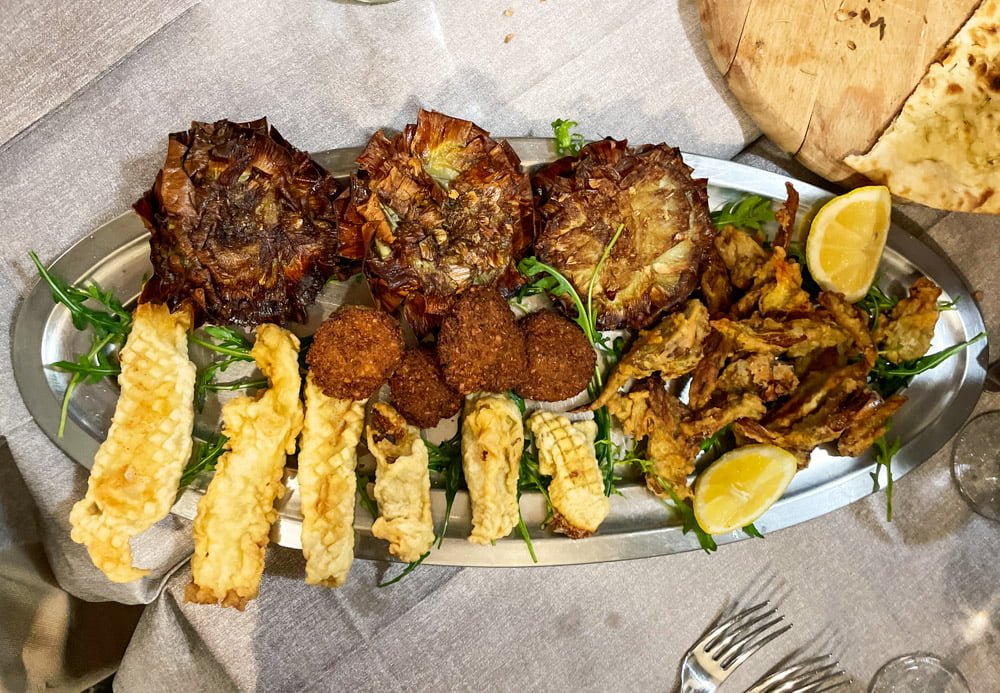
Restaurants
Among the most famous restaurants are Nonna Betta and Il Giardino Romano. Both serve Jewish-Roman dishes such as artichokes alla giudia, stuffed courgette flowers and salt cod, and classic Roman pasta dishes. It is a tasty cuisine with some Middle Eastern forays you cannot find in Roman trattorias. The artichoke alla giudia, for instance, is precisely typical of the Roman Jewish community and differs from the preparation of the artichoke alla romana.
At the Il Giardino Romano restaurant, which specialises in artichokes, I discovered the different types of cuts for different recipes, how to cook them at their best, and how to clean them. The result is a fried artichoke with crispy outer leaves like crisps and soft and tasty insides.
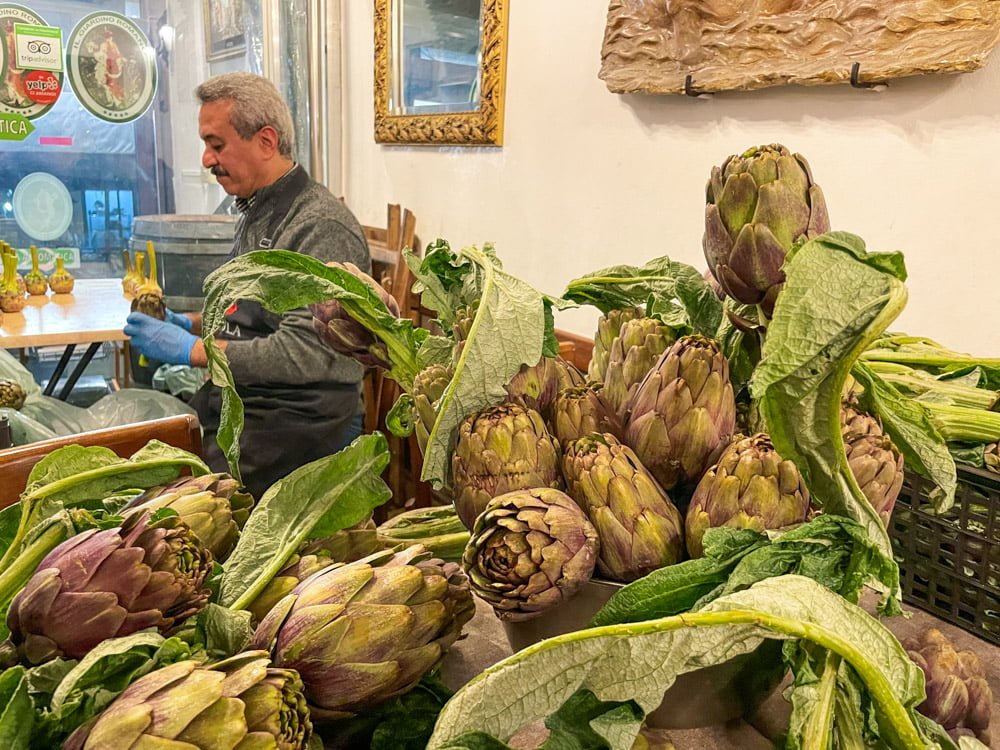
Bakeries and pastry shops
If you visit the Jewish Ghetto on a sunny day, you can buy pastries and focaccia in a bakery and eat ouside on a bench in Piazza del Cinque Scole. The Antico Forno Urbani has been in business since 1927 and prepares the thin Roman pizza, called ‘scrocchiarella’. The value for money is excellent, so you can try several pizzas for a few euros per slice.
For a sweet snack, I recommend Pasticceria Boccione, a historic bakery in the Ghetto of Rome, famous for its kosher baked goods. Although it has become a tourist attraction, sometimes with queues at the entrance, it is still a shop where the local Jewish community gets its supplies.
Unfortunately it is really costly for a bakery, especially compared to restaurant prices (consider around twenty euros for four slices of cake). However, the ricotta and sour cherry cake, a variety of sour cherry-like cherries, is divine and eating its soft filling worth every penny.
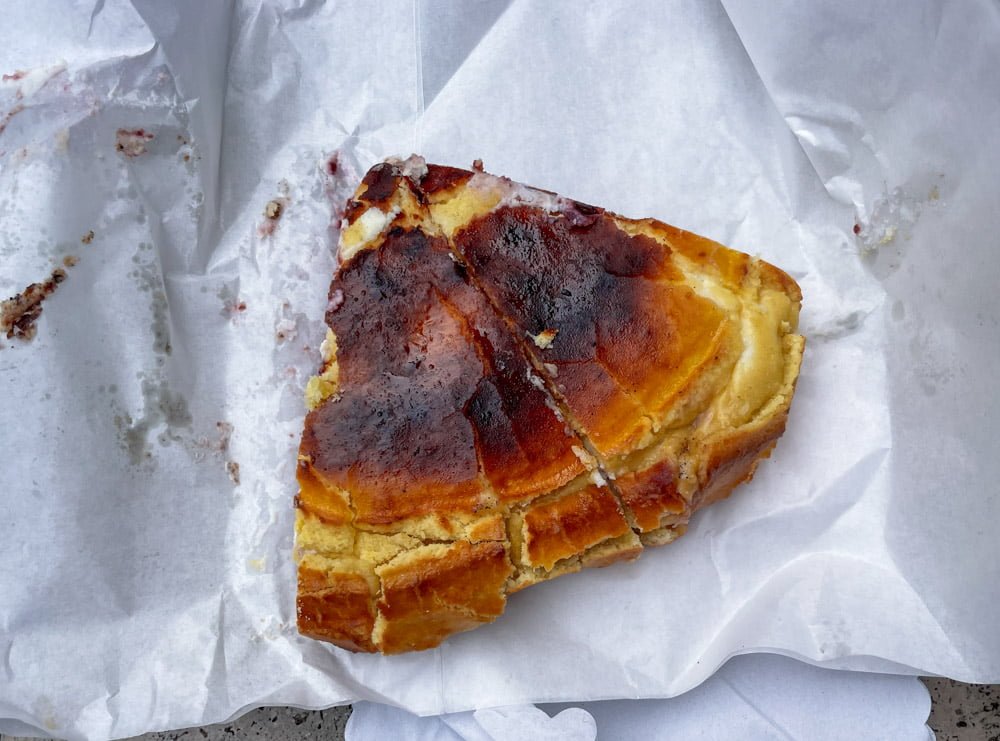
Practical information for visiting the Ghetto of Rome
The Ghetto di Roma is in the city centre, so you can easily add it to your Roman itinerary. You have to consider the different festivities of the Jewish community and the traffic in the capital to reach it.
When to visit the Ghetto of Rome
For the Jewish community, Saturday, called Shabbat שבת, is the day of rest. For this reason, museums and many kosher shops are closed during the Sabbath. Restaurants not run by Jewish community members, such as Il Giardino Romano, are open. In contrast, some kosher restaurants may offer a set menu service by reservation.
To visit all the shops and activities in the Ghetto open, I advise you to avoid Saturdays and choose another day of the week. Remember also that Jewish festivities follow a different calendar from the Italian calendar, so always check the opening hours of museums, activities, and restaurants you want to visit, just in case.
How to get to the Ghetto of Rome
The attractions of the Ghetto of Rome are all around Via del Portico d’Ottavia. The area of the Ghetto is relatively small, and it is easy to get around on foot. It is centrally located and well-served by public transport. It is only a few minutes walk from Piazza Venezia and the Fori Imperiali.
I recommend setting Via del Portico d’Ottavia on Google Maps to get there if you don’t have a specific destination in mind, such as a restaurant or museum. If you stay in the centre, you can easily get there on foot, walking through the city centre.
Remember that the traffic in Rome is always quite chaotic. Hence, avoid cars and public transport, apart from the metro, if you can. Romans move around by scooter and not by car when possible, so I advise against arriving at the Ghetto by car. Also, it is not easy to find parking.
Where to stay in Rome
I have tried several hotels in Rome during my travels and I recommend staying in the city centre to avoid the chaotic traffic of the capital. Among the hotels I suggest, the charming Roma Suites Navona has family rooms and is in a great location just a few steps from Piazza Navona.
If you prefer a hotel with a buffet breakfast, you can choose the Bloom Hotel Rome, very close to St Peter’s Basilica, while if you arrive by train, the best choice near Termini station is the DoubleTree By Hilton Rome Monti hotel with double and family rooms.
Feel free to comment if you already know the Jewish quarter of the capital, its museums, and good food. I really enjoyed it, and I recommend adding the Ghetto of Rome to the list of things to see on your trip.
